Charles E W Bean, Diaries, AWM38 3DRL 606/243A/1 - 1916 - 1934 - Part 14

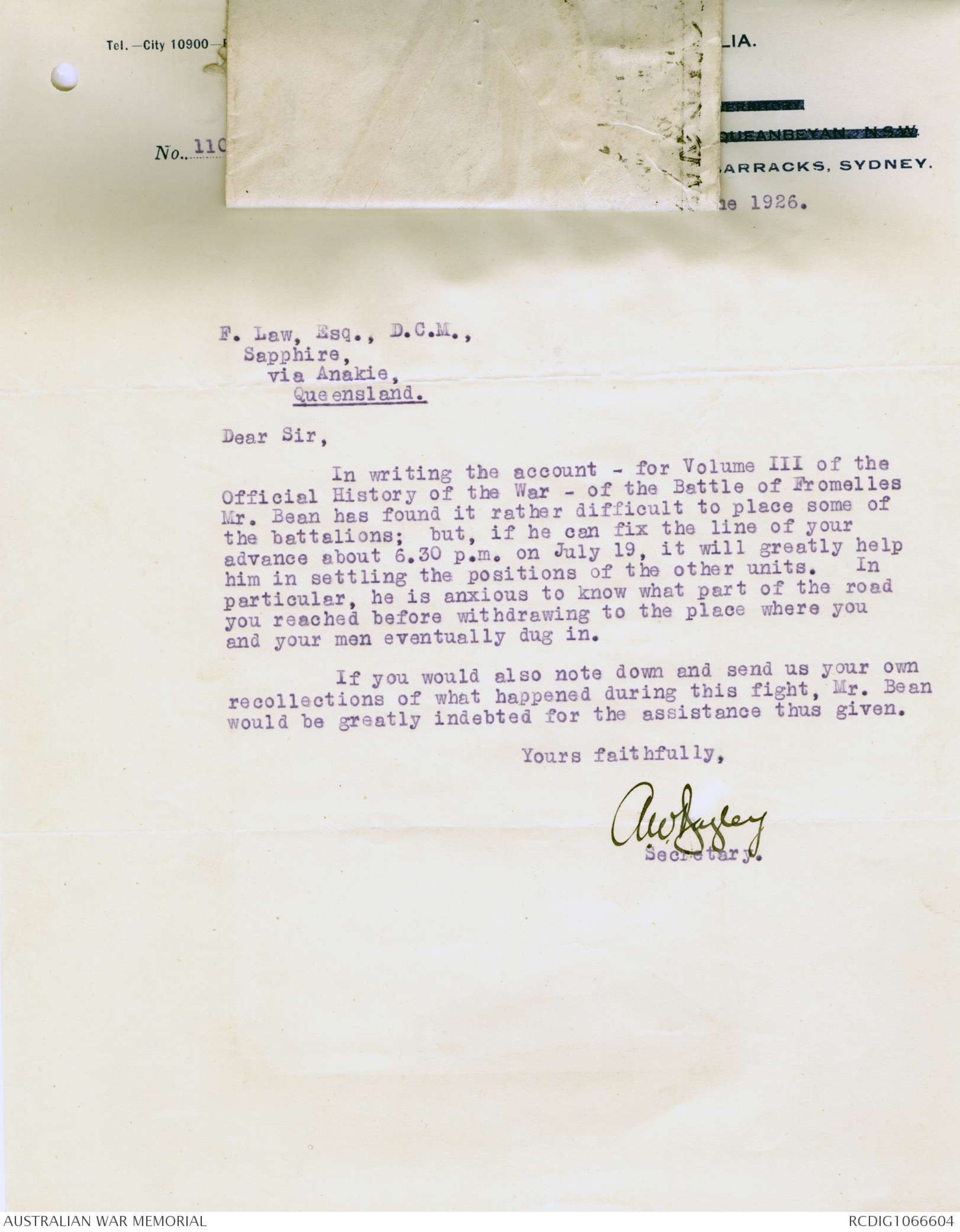

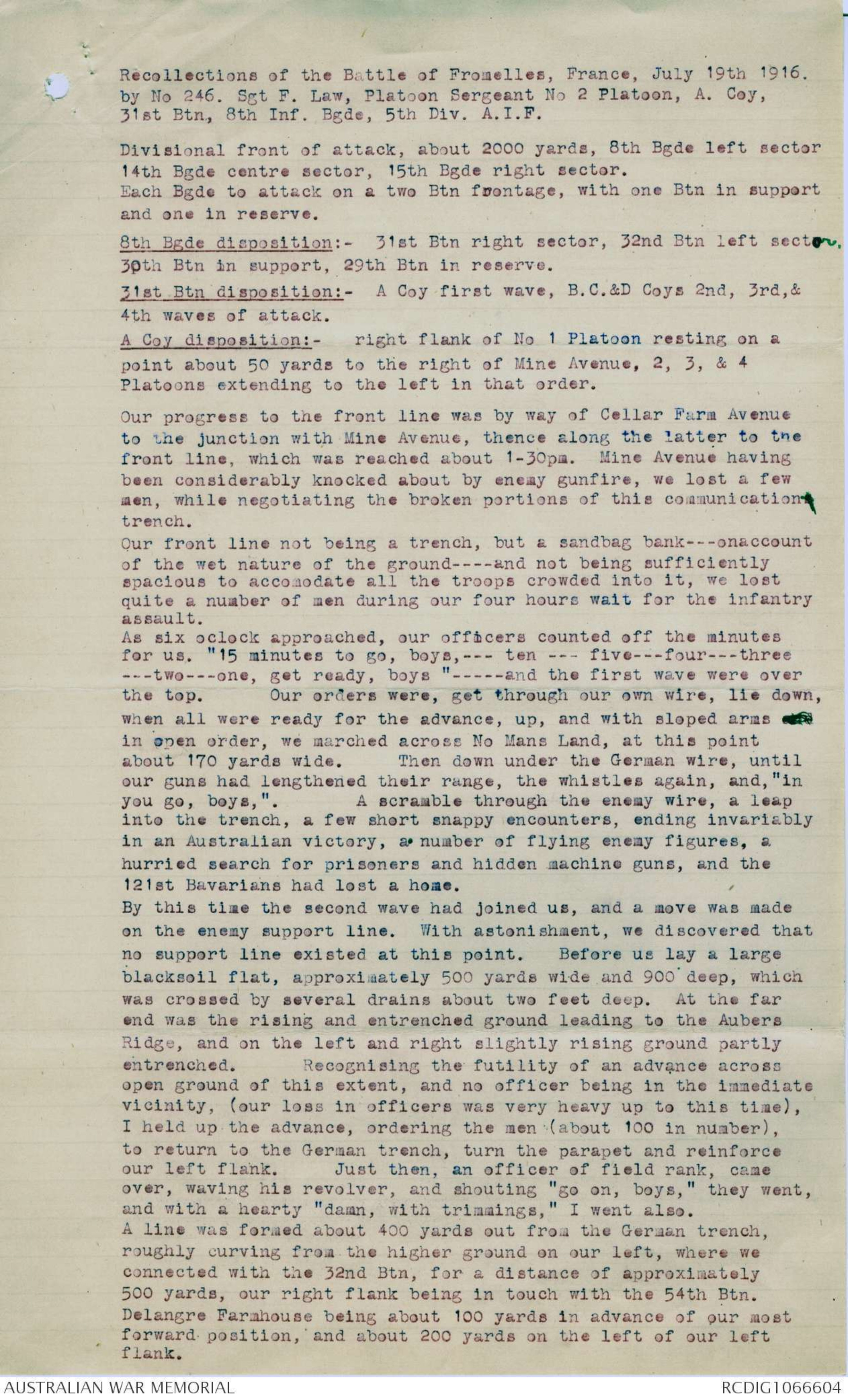
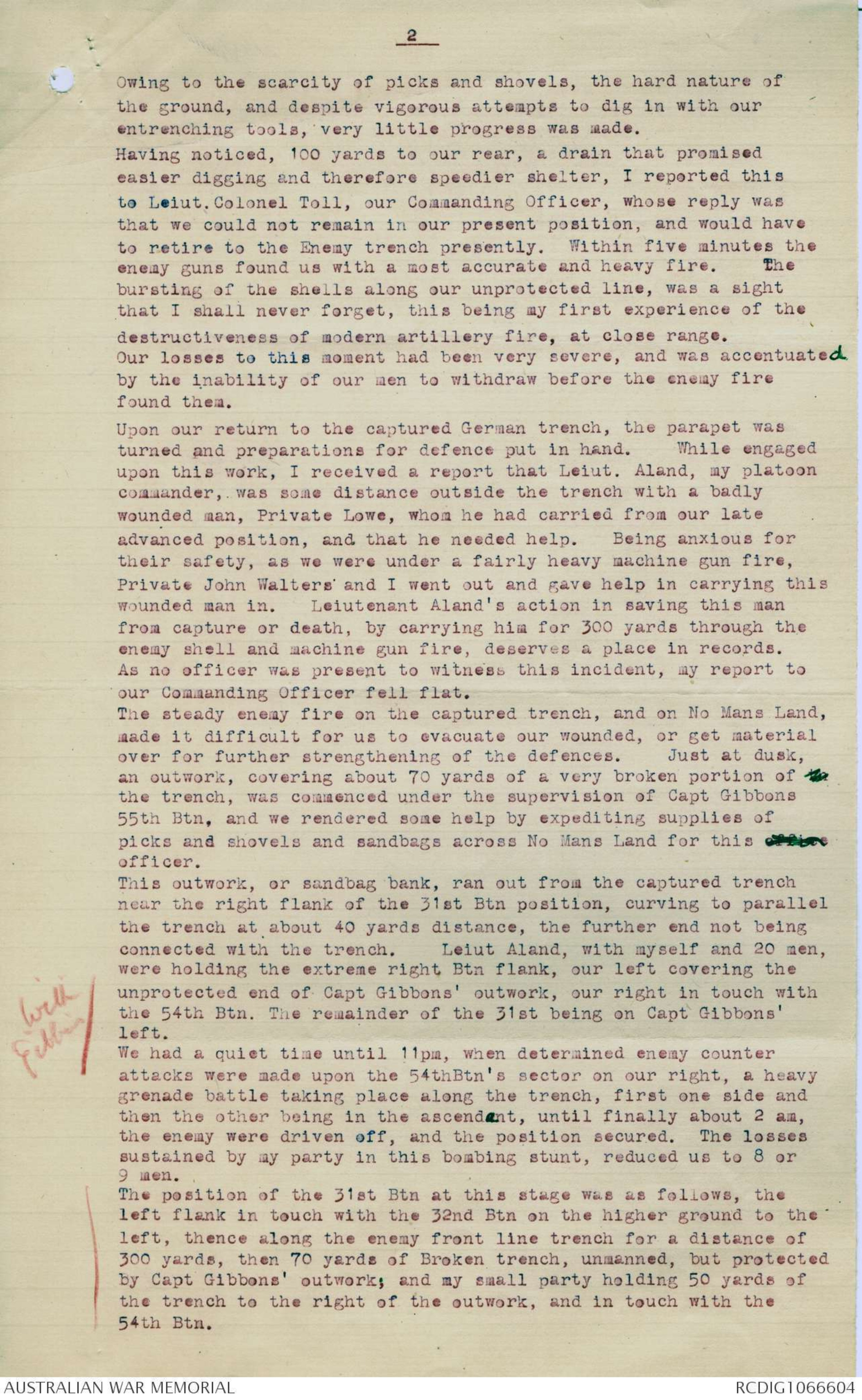

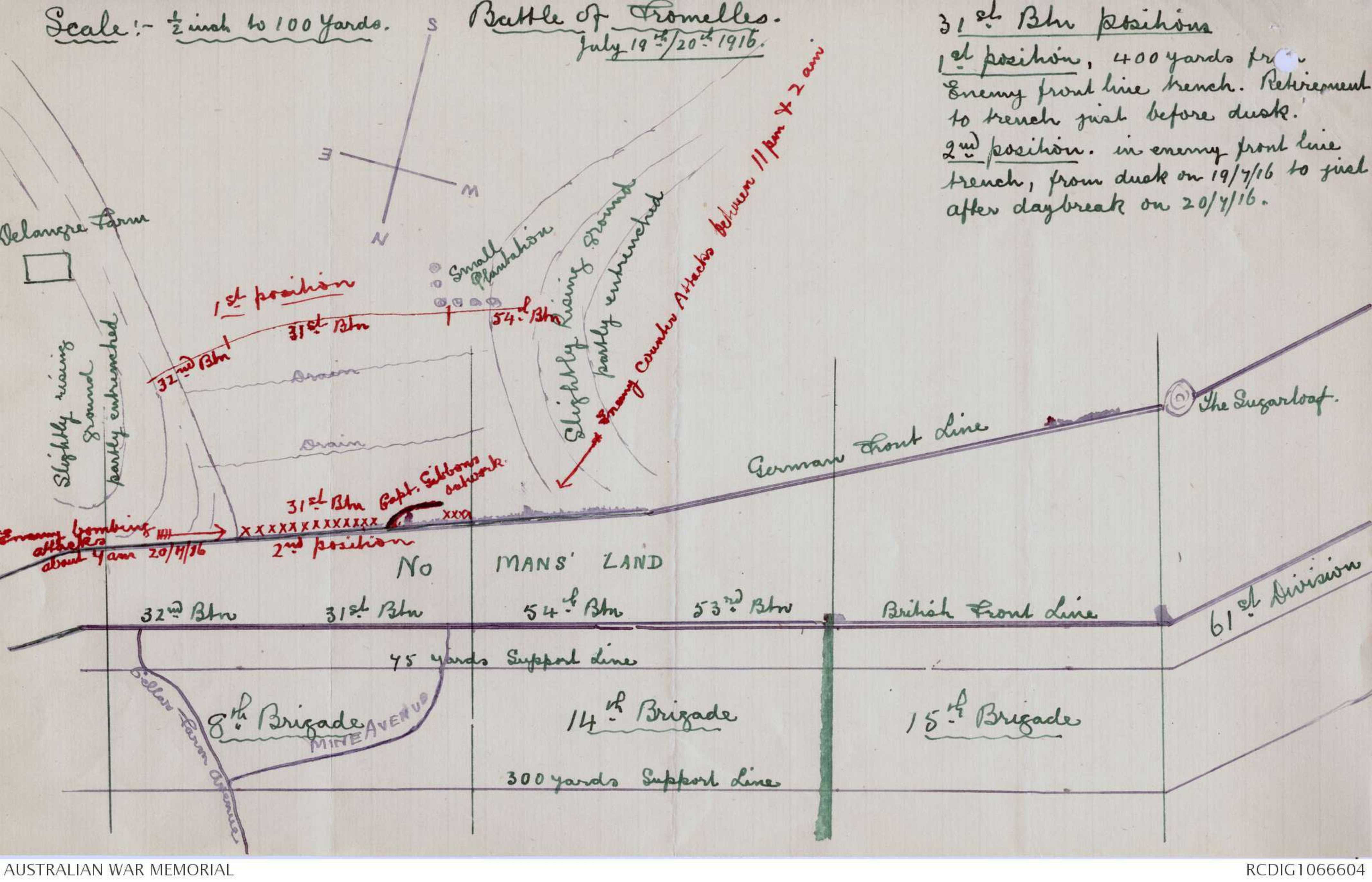
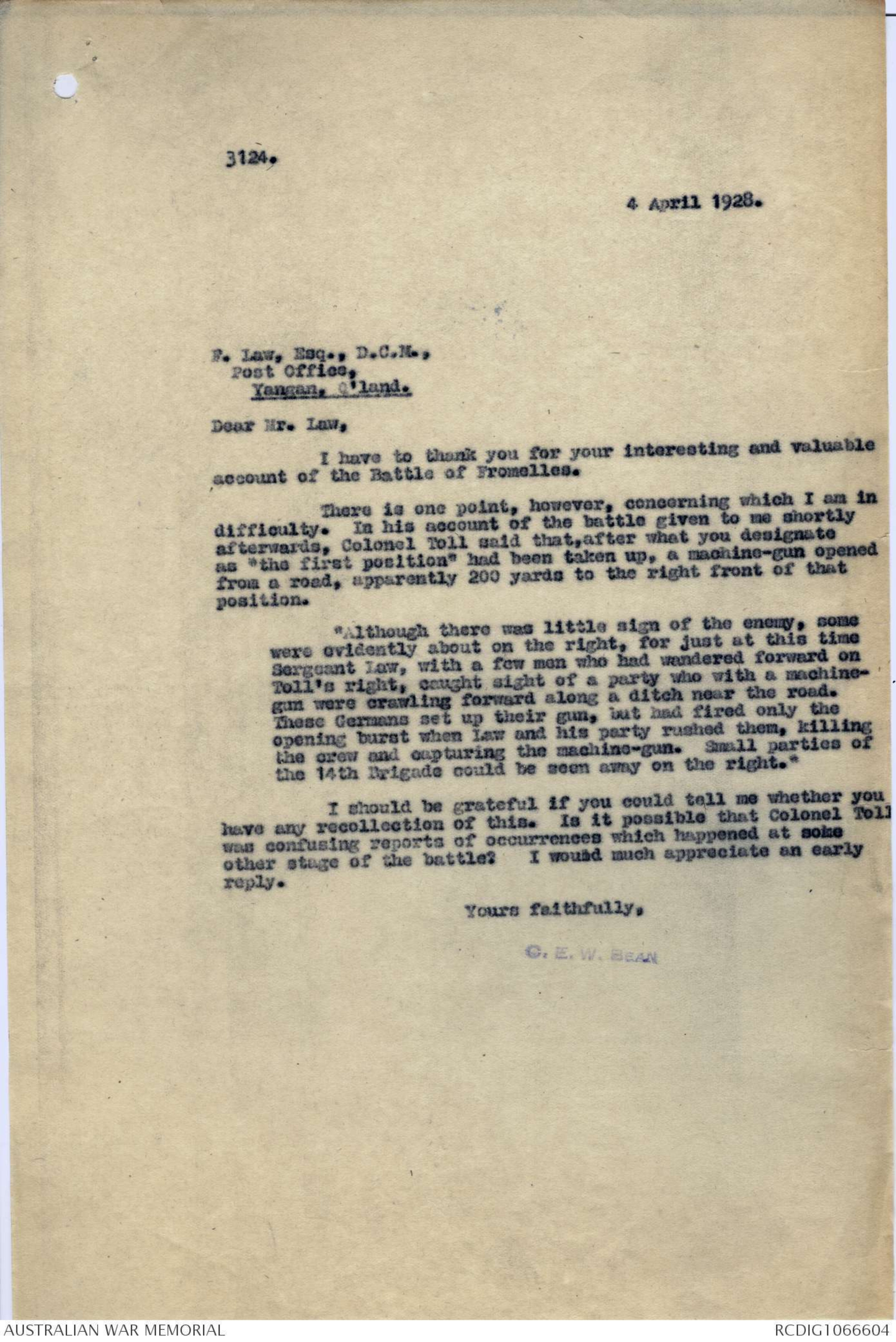
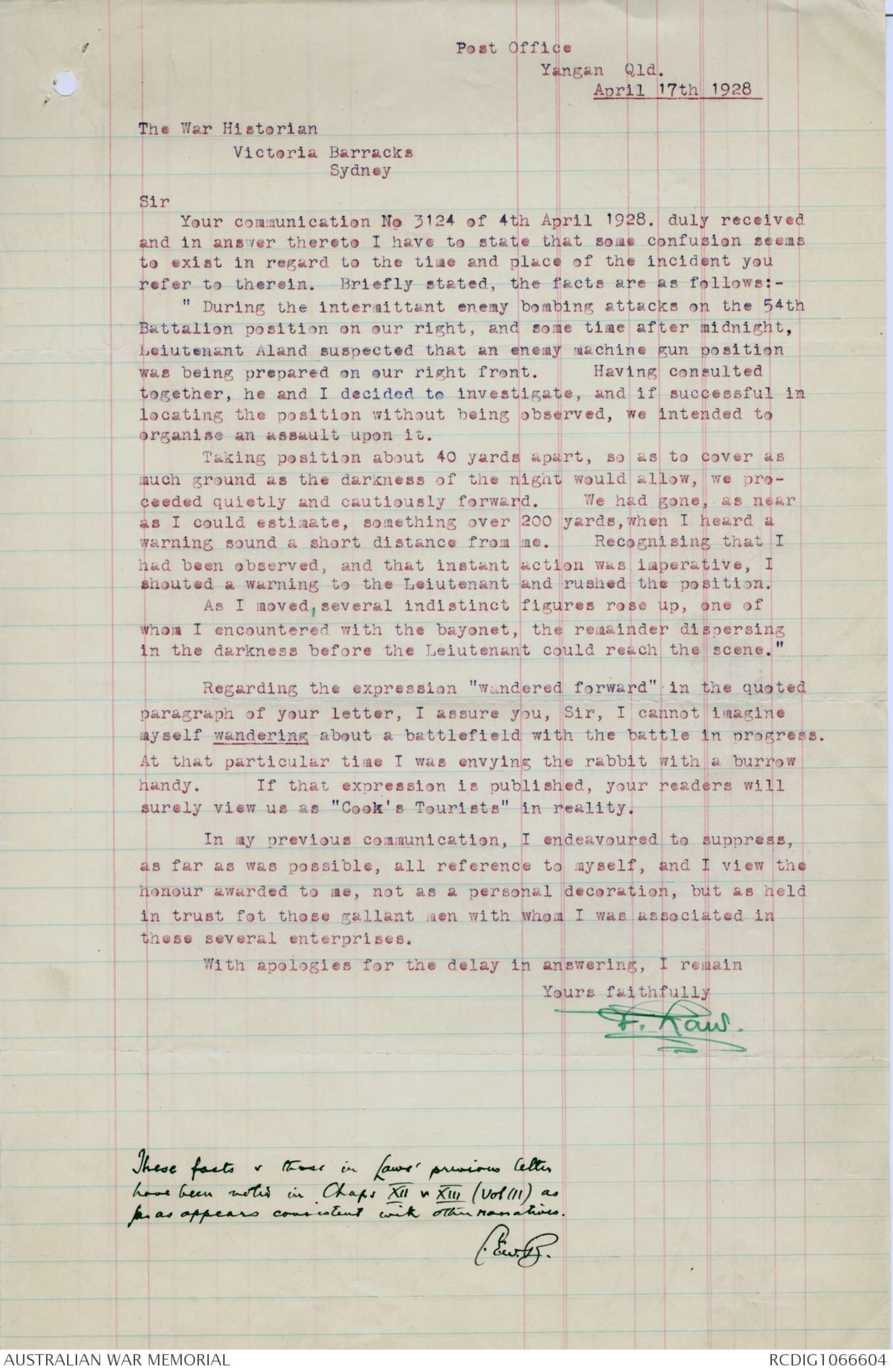
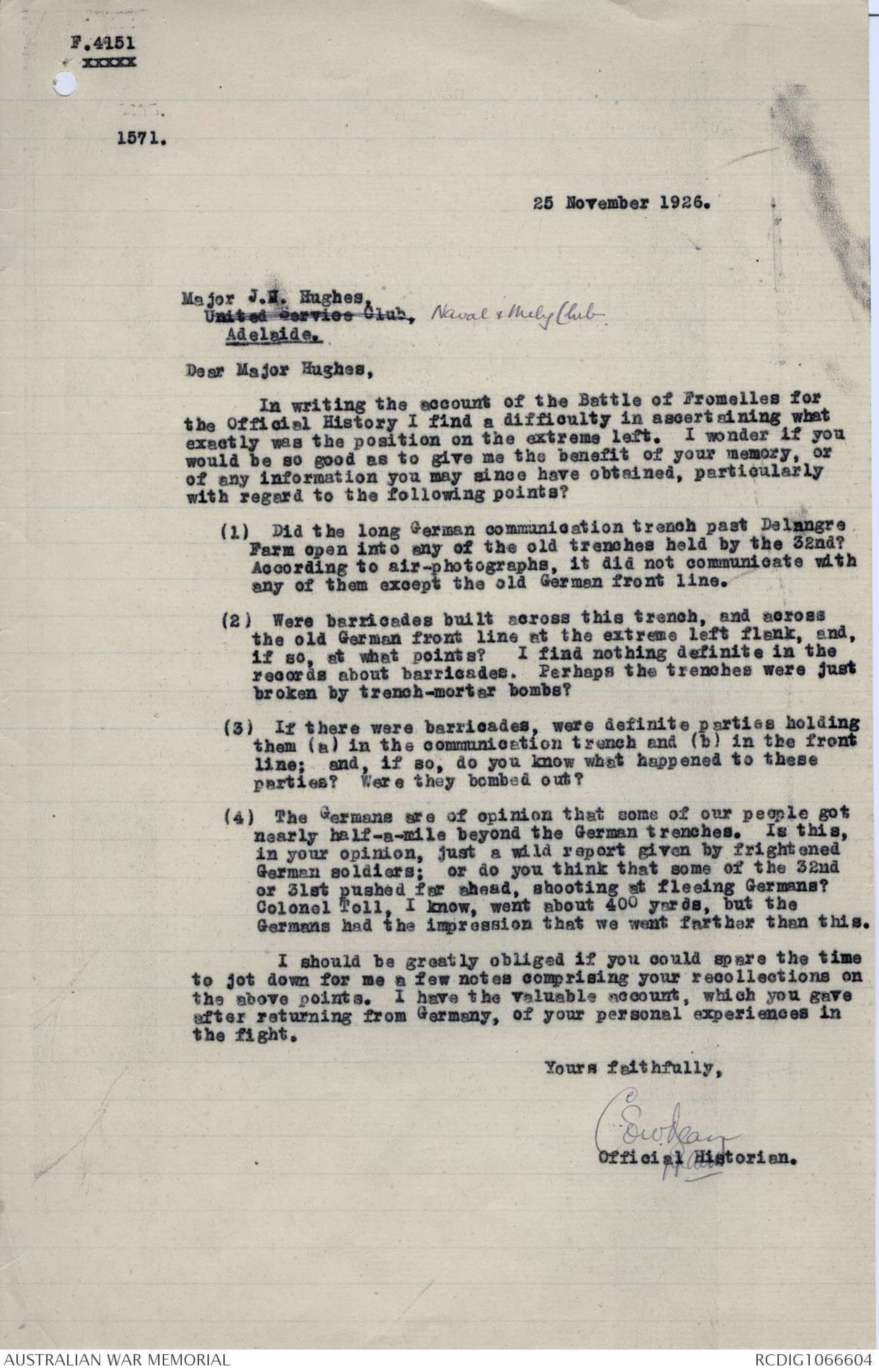
On His Majesty's Service
| O | ADDRESS MAIL TO | SYDNEY | ADDRESS MAIL TO | SYDNEY | ADDRESS | |
|
On His |
Majesty's | Service | ||||
|
OE11 5-PM 1926 |
P.O. BOX NO. |
OE11 5-PM 1926 |
P.O. BOX NO. |
CE11 5-PM 1926 |
P.O. BO | |
| ERY | NSW. | IT EXPEDITES DELIVERY | NSW. | IT EXPEDITES DELIVERY | NSW. | IT EXPEDITES |
| If not claimed within 7 days | |
| Please return to:- | |
| HISTORIAN, | |
| VICTORIA BARRACKS, | Refer to Historian |
| SYDNEY. | Victoria Barracks |
| Sydney | |
1926.
F. Law, Esq., D.C.M.,
Sapphire,
via Anakie,
Queensland.
Dear Sir,
In writing the account - for Volume III of the
Official History of the War - of the Battle of Fromelles
Mr. Bean has found it rather difficult to place some of
the battalions; but, if he can fix the line of your
advance about 6.30 p.m. on July 19, it will greatly help
him in settling the positions of the other units. In
particular, he is anxious to know what part of the road
you reached before withdrawing to the place where you
and your men eventually dug in.
If you would also note down and send us your own
recollections of what happened during this fight, Mr. Bean
would be greatly indebted for the assistance thus given.
Yours faithfully,
AW Bazley
Secretary.
Post Office
Yangan, Qld.
March 30th 1928.
The War Historian
Victoria Barracks
Sydney. N.S.W.
Dear Sir
Your No. 2979, dated 24th February 1928.
asking information relative to the Battle of
Fromelles July 19th 1916.
Enclosed please find my recollections of
this battle, the incidents, as depicted therein,
still remain fresh in my memory.
I must apologise for the length of
time it has taken me to reply, but my
present occupation leaves little leisure in
which to attend to other matters.
Tructing that the enclosure will
be of some little use to you, I remain
Sir, Yours faithfully
Francis Law.
Allowance Paymaster
Yangan, Qld
Recollections of the Battle of Fromelles, France, July 19th 1916.
by No 246. Sgt F. Law, Platoon Sergeant No 2 Platoon, A. Coy,
31st Btn, 8th Inf. Bgde, 5th Div. A.I.F.
Divisional front of attack, about 2000 yards, 8th Bgde left sector
14th Bgde centre sector, 15th Bgde right sector.
Each Bgde to attack on a two Btn frontage, with one Btn in support
and one in reserve.
8th Bgde disposition:- 31st Btn right sector, 32nd Btn left sector,
30th Btn in support, 29th Btn in reserve.
31st Btn disposition:- A Coy first wave, B.C.&D Coys 2nd, 3rd,
4th waves of attack.
A Coy disposition:- right flank of No 1 Platoon resting on a
point about 50 yards to the right of Mine Avenue, 2, 3, & 4
Platoons extending to the left in that order.
Our progress to the front line was by way of Cellar Farm Avenue
to the junction with Mine Avenue, thence along the latter to the
front line, which was reached about 1-30pm. Mine Avenue having
been considerably knocked about by enemy gunfire, we lost a few
men, while negotiating the broken portions of this communications
trench.
Our front line not being a trench, but a sandbag bank---onaccount
of the wet nature of the ground---and not being sufficiently
spacious to accomodate all the troops crowded into it, we lost
quite a number of men during our four hours wait for the infantry
assault.
As six oclock approached, our officers counted off the minutes
for us. "15 minutes to go, boys,--- ten --- five---four---three
---two---one, get ready, boys ".-----and the first wave were over
the top. Our orders were, get through our own wire, lie down,
when all were ready for the advance, up, and with sloped arms we
in open order, we marched across No Mans Land, at this point
about 170 yards wide. Then down under the German wire, until
our guns had lengthened their range, the whistles again, and, "in
you go, boys,". A scramble through the enemy wire, a leap
into the trench, a few short snappy encounters, ending invariably
in an Australian victory, a number of flying enemy figures, a
hurried search for prisoners and hidden machine guns, and the
121st Bavarians had lost a home.
By this time the second wave had joined us, and a move was made
on the enemy support line. With astonishment, we discovered that
no support line existed at this point. Before us lay a large
blacksoil flat, approximately 500 yards wide and 900 deep, which
was crossed by several drains about two feet deep. At the far
end was the rising and entrenched ground leading to the Aubers
Ridge, and on the left and right slightly rising ground partly
entrenched. Recognising the futility of an advance across
open ground of this extent, and no officer being in the immediate
vicinity, (our loss in officers was very heavy up to this time),
I held up the advance, ordering the men (about 100 in number),
to return to the German trench, turn the parapet and reinforce
our left flank. Just then, an officer of field rank, came
over, waving his revolver, and shouting "go on, boys,” they went,
and with a hearty "damn, with trimmings," I went also.
A line was formed about 400 yards out from the German trench,
roughly curving from the higher ground on our left, where we
connected with the 32nd Btn, for a distance of approximately
500 yards, our right flank being in touch with the 54th Btn.
Delangre Farmhouse being about 100 yards in advance of our most
forward position, and about 200 yards on the left of our left
flank.
2
Owing to the scarcity of picks and shovels, the hard nature of
the ground, and despite vigorous attempts to dig in with our
entrenching tools, very little progress was made.
Having noticed, 100 yards to our rear, a drain that promised
easier digging and therefore speedier shelter, I reported this
to Leiut. Colonel Toll, our Commanding Officer, whose reply was
that we could not remain in our present position, and would have
to retire to the Enemy trench presently. Within five minutes the
enemy guns found us with a most accurate and heavy fire. The
bursting of the shells along our unprotected line, was a sight
that I shall never forget, this being my first experience of the
destructiveness of modern artillery fire, at close range.
Our losses to this moment had been very severe, and was accentuated
by the inability of our men to withdraw before the enemy fire
found them.
Upon our return to the captured German trench, the parapet was
turned and preparations for defence put in hand. While engaged
upon this work, I received a report that Leiut. Aland, my platoon
commander, was some distance outside the trench with a badly
wounded man, Private Lowe, whom he had carried from our late
advanced position, and that he needed help. Being anxious for
their safety, as we were under a fairly heavy machine gun fire,
Private John Walters and I went out and gave help in carrying this
wounded man in. Leiutenant Aland's action in saving this man
from capture or death, by carrying him for 300 yards through the
enemy shell and machine gun fire, deserves a place in records.
As no officer was present to witness this incident, my report to
our Commanding Officer fell flat.
The steady enemy fire on the captured trench, and on No Mans Land,
made it difficult for us to evacuate our wounded, or get material
over for further strengthening of the defences. Just at dusk,
an outwork, covering about 70 yards of a very broken portion of th
the trench, was commenced under the supervision of Capt Gibbons
55th Btn, and we rendered some help by expediting supplies of
picks and shovels and sandbags across No Mans Land for this office
officer.
This outwork, or sandbag bank, ran out from the captured trench
near the right flank of the 31st Btn position, curving to parallel
the trench at about 40 yards distance, the further end not being
connected with the trench. Leiut Aland, with myself and 20 men,
were holding the extreme right Btn flank, our left covering the
unprotected end of Capt Gibbons' outwork, our right in touch with
the 54th Btn. The remainder of the 31st being on Capt Gibbons'
left.
[*with Gibbons*]
We had a quiet time until 11pm, when determined enemy counter
attacks were made upon the 54thBtn's sector on our right, a heavy
grenade battle taking place along the trench, first one side and
then the other being in the ascendant, until finally about 2 am,
the enemy were driven off, and the position secured. The losses
sustained by my party in this bombing stunt, reduced us to 8 or
9 men.
The position of the 31st Btn at this stage was as follows, the
left flank in touch with the 32nd Btn on the higher ground to the
left, thence along the enemy front line trench for a distance of
300 yards, then 70 yards of Broken trench, unmanned, but protected
by Capt Gibbons' outwork; and my small party holding 50 yards of
the trench to the right of the outwork, and in touch with the
54th Btn.
3
Shortly after daybreak, I was informed that the 31st Btn had
retired to our own lines. While making an investigation, I
was met at the entrance to the outwork, by Capt Gibbons, who
ordered me to get my few men, and hold the Btn sector on his
left, as he expected enemy attacks from that Quarter.
Having established and manned a temporary post, about 150 yards
to the left of Capt Gibbons' position, we attempted to seize
and hold the crown of the higher ground, a further 100 yards
to our left, but discovered a strong party of the enemy in
possession. A furious grenade fight now took place, the
enemy making five successive attempts to storm along the trench,
but each, in turn, were met and defeated by the gallantry and
resourcefulness of the eight men with me. (two of these,
Corporal Harry Dank and Private Jones, were A Coy men, the
other six, whose names I do not know, belonging to other Coys
of the 31st.). During a lull in the fighting, Capt Gibbons
came up to see what all the clatter was about, and was just
in time to take part in repulsing another attack, during which
he received a slight wound in the head. Up to this time, we
had held the position without a single casuality, and had
inflicted severe loss upon the enemy,. Seeing the precariousness
of the position, Capt Gibbons asked me to hold on
until he could remove his wounded across No Mans Land, this
accomplished, he sent word for us to withdraw, and he with
his 20 men would follow us. After seeing my men safely
across No Mans Land, I reported to Capt Gibbons, and that
officer ordered me to give his men the retire signal, which
I did. He then asked for and wrote my military particulars
in his pocketbook, and asked Leiut. Robinson to also sign,
shook hands with me, and I made my way across to our own lines,
which I reached at 8-45 am on the 20th.
We were withdrawn from the front line about midday, and went
back to our billets in Fleurbaix, a sadly depleted company,
and so ended my first experience of actual Battle.
F. Law.
Ex, No 246. Warrant Officer, Class 1. Francis Law.
Regimental-Sergeant-Major
31st Battalion
8th. Infantry Brigade
A.I.F.
P.S. I am enclosing rough plan of 31st Btn
positions, which may make the text a little
clearer. Only the approximate positions of the
front line trenches, German & British, is given.
Diagram - see original document
Battle of Fromelles.
July 19th/20th 1916.
31st Btn positions
1st position, 400 yards from
Enemy front line trench. Retirement
to trench just before dusk.
2nd position. in enemy front line
trench, from dusk on 19/7/16 to just
after daybeak on 20/7/16.
3124.
4 April 1928.
F. Law, Esq., D.C.M.,
Post Office,
Yangan. Q'land.
Dear Mr. Law,
I have to thank you for your interesting and valuable
account of the Battle of Fromelles.
There is one point, howevor, concerning which I am in
difficulty. In his account of the battle given to me shortly
afterwards, Colonel Toll said that, after what you designate
as "the first position" had been taken up, a machine-gun opened
from a road, apparently 200 yards to the right front of that
position.
"Although there was little sign of the enemy, some
were evidently about on the right, for just at this time
Sergeant Law, with a few men who had wandered forward on
Toll's right, caught sight of a party who with a machine-gun
were crawling forward along a ditch near the road.
These Germans set up their gun, but had fired only the
opening burst when Law and his party rushed them, killing
the crew and capturing the machine-gun. Small parties of
the 14th Brigade could be seen away on the right."
I should be grateful if you could tell me whether you
have any recollection of this. Is it possible that Colonel Toll
was confusing reports of occurrences which happened at some
other stage of the battle? I would much appreciate an early
reply.
Yours faithfully.
C.E.W. BEAN
Post Office
Yangan Qld.
APRIL 17TH 1928
The War Historian
Victoria Barracks
Sydney
SiR
Your communication No 3124 of 4th April 1928, duly received
and in answer thereto I have to state that some confusion seems
to exist in regard to the time and place of the incident you
refer to therein. Briefly stated, the facts are as follows:-
"During the intermittant enemy bombing attacks on the 54th
Battalion position on our right, and some time after midnight,
Leiutenant Aland suspected that an enemy machine gun position
was being prepared on our right front. Having consulted
together, he and I decided to investigate, and if successful in
locating the position without being observed, we intended to
organise an assault upon it.
Taking position about 40 yards apart, so as to cover as
much ground as the darkness of the night would allow, we proceeded
quietly and cautiously forward. We had gone, as near
as I could estimate, something over 200 yards, when I heard a
warning sound a short distance from me. Recognising that I
had been observed, and that instant action was imperative, I
shouted a warning to the Leiutenant and rushed the position.
As I moved, several indistinct figures rose up, one of
whom I encountered with the bayonet, the remainder dispersing
in the darkness before the Leiutenant could reach the scene."
Regarding the expression "wandered forward" in the quoted
paragraph of your letter, I assure you, Sir, I cannot imagine
myself wandering about a battlefield with the battle in progress.
At that particular time I was envying the rabbit with a burrow
handy. If that expression is published, your readers will
surely view us as "Cook's Tourists" in reality.
In my previous communication, I endeavoured to suppress,
as far as was possible, all reference to myself, and I view the
honour awarded to me, not as a personal decoration, but as held
in trust fot those gallant men with whom I was associated in
these several enterprises.
With apologies for the delay in answering, I remain
Yours faithfully
F. Law.
[*These facts & those in Law's previous letter
have been noted in Chaps XII & XIII (Vol 111) as
far as appears consistent with other narratives.
C.E.W.B.*]
F.4151
xxxxx
1571.
25 November 1926.
Major J.H. Hughes,United Services Club Naval & Mily Club
Adelaide.
Dear Major Hughes,
In writing the account of the Battle of Fromelles for
the Official History I find a difficulty in ascertaining what
exactly was the position on the extreme left. I wonder if you
would be so good as to give me the benefit of your memory, or
of any information you may since have obtained, particularly
with regard to the following points?
(1) Did the long German communication trench past Delangre
Farm open into any of the old trenches held by the 32nd?
According to air-photographs, it did not communicate with
any of them except the old German front line.
(2) Were barricades built across this trench, and across
the old German front line at the extreme left flank, and
if so, at what points? I find nothing definite in the
records about barricades. Perhaps the trenches were just
broken by trench-mortar bombs?
(3) If there were barricades, were definite parties holding
them (a) in the communication trench and (b) in the front
line; and, if so, do you know what happened to these
parties? Were they bombed out?
(4) The Germans are of opinion that some of our people got
nearly half-a-mile beyond the German trenches. Is this,
in your opinion, just a wild report given by frightened
German soldiers; or do you think that some of the 32nd
or 31st pushed far ahead, shooting at fleeing Germans?
Colonol Toll, I know, went about 400 yards, but the
Germans had the impression that we went farther than this.
I should be greatly obliged if you could spare the time
to jot down for me a few notes comprising your recollections on
the above points. I have the valuable account, which you gave
after returning from Germany, of your personal experiences in
the fight.
Yours faithfully,
C.E.W. Bean
Official Historian.
 Deb Parkinson
Deb ParkinsonThis transcription item is now locked to you for editing. To release the lock either Save your changes or Cancel.
This lock will be automatically released after 60 minutes of inactivity.